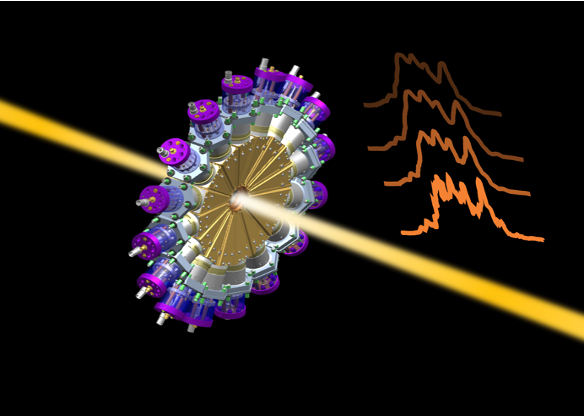Atomic, Molecular and Optical Physics
AMOThe atomic, molecular and optical (AMO) physics group explores the frontiers of x-ray science with a combined theoretical and experimental approach employing advanced synchrotron and x-ray free electron laser sources and Argonne’s large-scale computational facilities. Advances in wavefront and polarization control of x-ray pulses combined with tailored optical excitation methods offer a new window for understanding and controlling photoinduced molecular interactions in increasingly complex systems. By aiming for a quantitative and predictive understanding of x-ray interactions with atoms and molecules in gas and condensed phases, both in the linear and nonlinear x-ray interaction regimes, this research lays the foundation for x-ray applications in other scientific domains.
Nonlinear x-ray interactions
X-ray free electron lasers (XFELs) have spawned an era characterized by multiphoton x-ray interactions with matter. Nonlinear and ultrafast x-ray interaction processes are now accessible, thanks to x-ray pulses with peak brightness a billion times greater than previously available. When nonlinear spectroscopies were developed in the optical regime, a wealth of novel techniques provided new insights on ultrafast photophysical and photochemical processes. X-ray science is experiencing a similar revolution with the development of stimulated x-ray Raman scattering, x-ray transient grating, three-and four-wave mixing and more. We develop new ways to probe molecules and single particles, with both resonant and non-resonant interactions, by using forefront tools, namely XFELs, upgraded synchrotron sources and high-performance computers. We also design innovative ways to implement these challenging spectroscopic techniques by using the random nature of FEL beams to our advantage with stochastic spectroscopies.
- Kai Li, et al., “Ghost-imaging-enhanced noninvasive spectral characterization of stochastic x-ray free-electron-laser pulses, ” Communications Physics 5, 191 (2022). https://doi.org/10.1038/s42005-022-00962-8
- Phay J Ho, et al., “Fluorescence intensity correlation imaging with high spatial resolution and elemental contrast using intense x-ray pulses,” Structural Dynamics 8, 044101 (2021). https://doi.org/10.1063/4.0000105
- Kai Li, et al., “Resonant propagation of x rays from the linear to the nonlinear regime,” Physical Review A 102, 053113 (2020). https://doi.org/10.1103/PhysRevA.102.053113
Ultrafast molecular photophysics
Understanding x-ray-initiated processes in isolated molecules is a grand challenge problem with broad implications for radiation chemistry, physics and biology. High-brightness tunable ultrafast x-ray pulses are now able to track both inner- and outer-shell electronic motion on their natural timescales with chemical site specificity. These time-resolved studies are complemented by precision, coincidence spectroscopies at synchrotrons, like the Advanced Photon Source APS at Argonne. The combination of pump-probe and coincident x-ray experiments allows us to isolate motion prior to inner-shell decay and determine the mechanisms that lead to the final outcomes. We take advantage of new control parameters of x-ray pulses such as their polarization, spatial structure, stochasticity.
- Phay J. Ho, et al., “X-ray induced electron and ion fragmentation dynamics in IBr”. J. Chem. Phys. 158, 134304 (2023). https://doi.org/10.1063/5.0145215
- Andre Al-Haddad, et al., “Tracking ultrafast change in the chemical environment from electron relaxation to nuclear dynamics,” Nat. Comm. 13, 7170 (2022). https://doi.org/10.1038/s41467-022-34670-2
- Adam E A Fouda, et al., “Resonant Double-Core Excitations with Ultrafast, Intense Pulses,” Mol. Phys., 121, e2133749 (2022). https://doi.org/10.1080/00268976.2022.2133749
Chemical dynamics in solution phase
We focus on understanding the fundamentals of molecular dynamics in solution induced by optical lasers or x-ray pulses and probed by high-precision, time-resolved x-ray methods. We consider timescales ranging from the attosecond to the microsecond regime, encompassing phenomena ranging from the first steps following photoabsorption triggering electronic dynamics to subsequent processes involving nuclear dynamics. We are especially interested in ligand nuclear dynamics and spin changes in metal complexes. We aim at understanding the solvent and counterion influence on reactivity and on controlling photoinduced outcomes by using feedback loops. Circularly polarized x-ray pulses also allow us to probe chiral complexes, relevant for the catalysis of asymmetric reactions. Our scientific objectives are pursued using XFELs and the upgraded Advanced Photon Source APS and are complemented by a range of optical techniques available at the Center for Nanoscale Materials CNM.
- Shuai Li, et al., “Attosecond-pump attosecond-probe x-ray spectroscopy of liquid water,” Science 383, 1118 (2024). https://doi:10.1126/science.adn6059.
- Arturo Sopena Moros, et al. , “Tracking Cavity Formation in Electron Solvation: Insights from X-ray Spectroscopy and Theory”, J. Am. Chem. Soc. 146, 5, 3262-3269 (2024). https://doi.org/10.1021/jacs.3c11857
- Eli Diego Kinigstein, et al., “Asynchronous x-ray multiprobe data acquisition for x-ray transient absorption spectroscopy.” Rev. Sci. Instrum. 94, 014714 (2023). https://doi.org/10.1063/5.0100596
- Victor M. Freixas, et al., “X-ray and optical circular dichroism as local and global ultrafast chiral probes of [12] helicene racemization.” J. Am. Chem. Soc. 145, 21012-21019 (2023). https://doi.org/10.1021/jacs.3c07032


